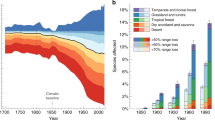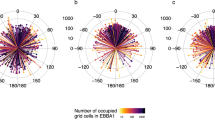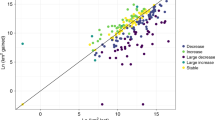Abstract
Forecasts of species range shifts under climate change most often rely on ecological niche models, in which characterizations of climate suitability are highly contingent on the species range data used. If ranges are far from equilibrium under current environmental conditions, for instance owing to local extinctions in otherwise suitable areas, modelled environmental suitability can be truncated, leading to biased estimates of the effects of climate change. Here we examine the impact of such biases on estimated risks from climate change by comparing models of the distribution of North American mammals based on current ranges with ranges accounting for historical information on species ranges. We find that estimated future diversity, almost everywhere, except in coastal Alaska, is drastically underestimated unless the full historical distribution of the species is included in the models. Consequently forecasts of climate change impacts on biodiversity for many clades are unlikely to be reliable without acknowledging anthropogenic influences on contemporary ranges.
This is a preview of subscription content, access via your institution
Access options
Access Nature and 54 other Nature Portfolio journals
Get Nature+, our best-value online-access subscription
$29.99 / 30 days
cancel any time
Subscribe to this journal
Receive 12 print issues and online access
$209.00 per year
only $17.42 per issue
Buy this article
- Purchase on Springer Link
- Instant access to full article PDF
Prices may be subject to local taxes which are calculated during checkout


Similar content being viewed by others
References
Pereira, H. M. et al. Scenarios for global biodiversity in the 21st century. Science 330, 1496–1501 (2010).
Maxwell, S. L., Fuller, R. A., Brooks, T. M. & Watson, J. E. M. The ravages of guns, nets and bulldozers. Nature 536, 143–145 (2016).
Urban, M. C. Accelerating extinction risk from climate change. Science 348, 571–573 (2015).
Heikkinen, R. K. et al. Methods and uncertainties in bioclimatic modelling under climate change. Prog. Phys. Geog. 30, 751–777 (2006).
Dawson, T. P., Jackson, S. T., House, J. I., Prentice, I. C. & Mace, G. M. Beyond predictions: biodiversity conservation in a changing climate. Science 332, 53–58 (2011).
Araújo, M. B. & Rahbek, C. Ecology. How does climate change affect biodiversity? Science 313, 1396–1397 (2006).
Thuiller, W., Brotons, L., Araújo, M. B. & Lavorel, S. Effects of restricting environmental range of data to project current and future species distributions. Ecography 27, 165–172 (2004).
Barbet-Massin, M., Thuiller, W. & Jiguet, F. How much do we overestimate future local extinction rates when restricting the range of occurrence data in climate suitability models? Ecography 33, 878–886 (2010).
Laliberte, A. A. & Ripple, W. J. Range contractions of North American carnivores and ungulates. Bioscience 54, 123–138 (2004).
Faurby, S. & Svenning, J. C. Historic and prehistoric human-driven extinctions have reshaped global mammal diversity patterns. Divers. Distrib. 21, 1155–1166 (2015).
Werdelin, L. & Lewis, M. E. Temporal change in functional richness and evenness in the eastern African Plio-Pleistocene carnivoran guild. PLoS ONE 8, e57944 (2013).
Di Marco, M. & Santini, L. Human pressures predict species’ geographic range size better than biological traits. Glob. Change Biol. 21, 2169–2178 (2015).
Faurby, S. & Araújo, M. B. Anthropogenic impacts weaken Bergmann’s rule. Ecography 40, 683–684 (2017).
Sandom, C., Faurby, S., Sandel, B. & Svenning, J. C. Global late Quaternary megafauna extinctions linked to humans, not climate change. Proc. R. Soc. B 281, 20133254 (2014).
Bartlett, L. J. et al. Robustness despite uncertainty: regional climate data reveal the dominant role of humans in explaining global extinctions of Late Quaternary megafauna. Ecography 39, 152–161 (2016).
Diamond, J. Collapse: How Societies Choose to Fail or Succeed (Penguin Books, London, UK, 2005).
Cheaib, A. et al. Climate change impacts on tree ranges: model intercomparison facilitates understanding and quantification of uncertainty. Ecol. Lett. 15, 533–544 (2012).
Ay, J. S., Guillemot, J., Martin-StPaul, N., Doyen, L. & Leadley, P. The economics of land use reveals a selection bias in tree species distribution models. Glob. Ecol. Biogeogr. 26, 65–77 (2017).
Pacifici, M. et al. Species’ traits influenced their response to recent climate change. Nat. Clim. Change 7, 205–208 (2017).
Araújo, M. B., Alagador, D., Cabeza, M., Nogués-Bravo, D. & Thuiller, W. Climate change threatens European conservation areas. Ecol. Lett. 14, 484–492 (2011).
Burns, C. E., Johnston, K. M. & Schmitz, O. J. Global climate change and mammalian species diversity in U.S. national parks. Proc. Natl Acad. Sci. USA 100, 11474–11477 (2003).
Wetzel, F. T., Kissling, W. D., Beissmann, H. & Penn, D. J. Future climate change driven sea-level rise: secondary consequences from human displacement for island biodiversity. Glob. Change Biol. 18, 2707–2719 (2012).
Nogués-Bravo, D. et al. Amplified plant turnover in response to climate change forecast by Late Quaternary records. Nat. Clim. Change 6, 1115–1119 (2016).
Sandom, C. J., Ejrnæs, R., Hansen, M. D. D. & Svenning, J. C. High herbivore density associated with vegetation diversity in interglacial ecosystems. Proc. Natl Acad. Sci. USA 111, 4162–4167 (2014).
Daskin, J. H., Stalmans, M. & Pringle, R. M. Ecological legacies of civil war: 35-year increase in savanna tree cover following wholesale large-mammal declines. J. Ecol. 104, 79–89 (2016).
Doughty, C. E., Faurby, S. & Svenning, J. C. Did megafauna extinctions affect savanna woody cover in South America? Ecography 39, 213–222 (2016).
Lomolino, M. V. & Channell, R. Splendid isolation: patterns of geographic range collapse in endangered mammals. J. Mammal. 76, 335–347 (1995).
Hanski, I. Dynamics of regional distribution: the core and satellite species hypothesis. Oikos 38, 210–221 (1982).
Nogués-Bravo, D. Predicting the past distribution of species climatic niches. Glob. Ecol. Biogeogr. 18, 521–531 (2009).
Beale, C. M., Brewer, M. J. & Lennon, J. L. A new statistical framework for the quantification of covariate associations with species distributions. Methods Ecol. Evol. 5, 421–432 (2014).
Thuiller, W., Georges, D. & Engler, R. biomod2: Ensemble Platform for Species Distribution Modeling. R package Version 2 (2016); https://cran.r-project.org/web/packages/biomod2/
Garcia, R. A., Burgess, N. D., Cabeza, M., Rahbek, C. & Araújo, M. B. Exploring consensus in 21st century projections of climatically suitable areas for African vertebrates. Glob. Change Biol. 18, 1253–1269 (2012).
Allouche, O., Tsoar, A. & Kadmon, R. Assessing the accuracy of species distribution models: prevalence, kappa and the true skill statistic (TSS). J. Appl. Ecol. 43, 1223–1232 (2006).
Araújo, M. B., Whittaker, R. J., Ladle, R. J. & Erhard, M. Reducing uncertainty in extinction risk from climate change. Glob. Ecol. Biogeogr. 14, 529–538 (2005).
Faurby, S. & Svenning, J. C. Resurrection of the island rule: human-driven extinctions have obscured a basic evolutionary pattern. Am. Nat. 187, 812–820 (2016).
The IUCN Red List of Threatened Species (IUCN, accessed 1 June 2015); http://www.iucnredlist.org
Hall, E. R. The Mammals of North America (Wiley, New York, USA, 1981).
Goring, S. et al. Neotoma: a programmatic interface to the Neotoma paleoecological database. Open Quat. 1, 2 (2015).
Faurby, S. & Svenning, J. C. A species-level phylogeny for all extant and Late Quaternary extinct mammals using a novel heuristic-hierarchical Bayesian approach. Mol. Phylogenet. Evol. 84, 14–26 (2015).
Harris, I., Jones, P. D., Osborn, T. J. & Lister, D. H. Updated high-resolution grids of monthly climatic observations – the CRU TS3.10 Dataset. Int. J. Climatol. 34, 623–642 (2014).
Worldclim Version 1.4 (Worldclim); http://www.worldclim.org
Batra, P. O. An Assessment of Interactively Coupled Paleoclimate-Vegetation Models. PhD thesis, Pennsylvania State Univ. (2003).
Otto-Bliesner, B. L., Marshall, S. J., Overpeck, J. T., Miller, G. H. & Hu, A. Simulating Arctic climate warmth and icefield retreat in the last interglaciation. Science 311, 1751–1753 (2006).
University of Copenhagen Data, Icesamples and Software (Univ. Copenhagen, 2016); http://www.iceandclimate.nbi.ku.dk/data/
Andersen, K. A. et al. The Greenland ice core chronology 2005, 15–42 ka. Part 1: constructing the time scale. Quat. Sci. Rev. 25, 3246–3257 (2006).
Rasmussen, S. O. et al. A new Greenland ice core chronology for the last glacial termination. J. Geophys. Res. Atmos. 111, D06102 (2006).
Vinther, B. M. et al. A synchronized dating of three Greenland ice cores throughout the Holocene. J. Geophys. Res. Atmos. 111, D13102 (2006).
Svensson, A. et al. A 60,000 year Greenland stratigraphic ice core chronology. Clim. Past. 4, 47–57 (2008).
Wolff, E. W., Chappellaz, J., Blunier, T., Rasmussen, S. O. & Svensson, A. Millennial-scale variability during the last glacial: the ice core record. Quat. Sci. Rev. 29, 2828–2838 (2010).
Meinshausen, M. et al. The RCP greenhouse gas concentrations and their extensions from 1765 to 2300. Clim. Change 109, 213–241 (2011).
Barbet-Massin, M., Jiguet, F., Albert, C. H. & Thuiller, W. Selecting pseudo-absences for species distribution models: how, where and how many? Methods Ecol. Evol. 3, 327–338 (2012).
Franklin, J. Mapping Species Distributions: Spatial Inference and Prediction (Cambridge Univ. Press, Cambridge, UK, 2010).
Diniz-Filho, J. A. et al. Partitioning and mapping uncertainties in ensembles of forecasts of species turnover under climate changes. Ecography 32, 897–906 (2009).
Araújo, M. B., Thuiller, W. & Yoccoz, N. G. Reopening the climate envelope reveals macroscale associations with climate in European birds. Proc. Natl Acad. Sci. USA 106, E45–E46 (2009).
Moreno-Amat, E. et al. Impact of model complexity on cross-temporal transferability in Maxent species distribution models: An assessment using paleobotanical data. Ecol. Modell. 312, 308–317 (2015).
Acknowledgements
S.F. was supported by the Danish Natural Science Research Council #4090-00227 and vetenskabsrådet (The Swedish research council) #2017-03862. M.B.A. acknowledges support from AAG-MAA/3764/2014 and the Spanish Research Council (CSIC) for his work and support from the Danish Natural Science Research Council to the Centre for Macroecology, Evolution and Climate (CMEC). We thank C. Bacon for helpful comments on an earlier version of the manuscript.
Author information
Authors and Affiliations
Contributions
S.F. and M.B.A. designed research; S.F. performed research; S.F. analysed data; S.F. and M.B.A. wrote the paper.
Corresponding author
Ethics declarations
Competing interests
The authors declare no competing interests.
Additional information
Publisher’s note: Springer Nature remains neutral with regard to jurisdictional claims in published maps and institutional affiliations.
Supplementary information
Supplementary Information
Supplementary Figures 1–7 and Supplementary Tables 1–5
Supplementary Data 1
The file lists all records from GBIF which we did not include and all records where our taxonomical assignment was different to the original taxonomy from GBIF
Rights and permissions
About this article
Cite this article
Faurby, S., Araújo, M.B. Anthropogenic range contractions bias species climate change forecasts. Nature Clim Change 8, 252–256 (2018). https://doi.org/10.1038/s41558-018-0089-x
Received:
Accepted:
Published:
Issue Date:
DOI: https://doi.org/10.1038/s41558-018-0089-x
This article is cited by
-
Future temperature extremes threaten land vertebrates
Nature (2023)
-
Extreme shifts in habitat suitability under contemporary climate change for a high-Arctic herbivore
Climatic Change (2023)
-
Local colonisations and extinctions of European birds are poorly explained by changes in climate suitability
Nature Communications (2023)
-
Vulnerability to climate change of species in protected areas in Thailand
Scientific Reports (2022)
-
Effects of diversity on thermal niche variation in bird communities under climate change
Scientific Reports (2022)



